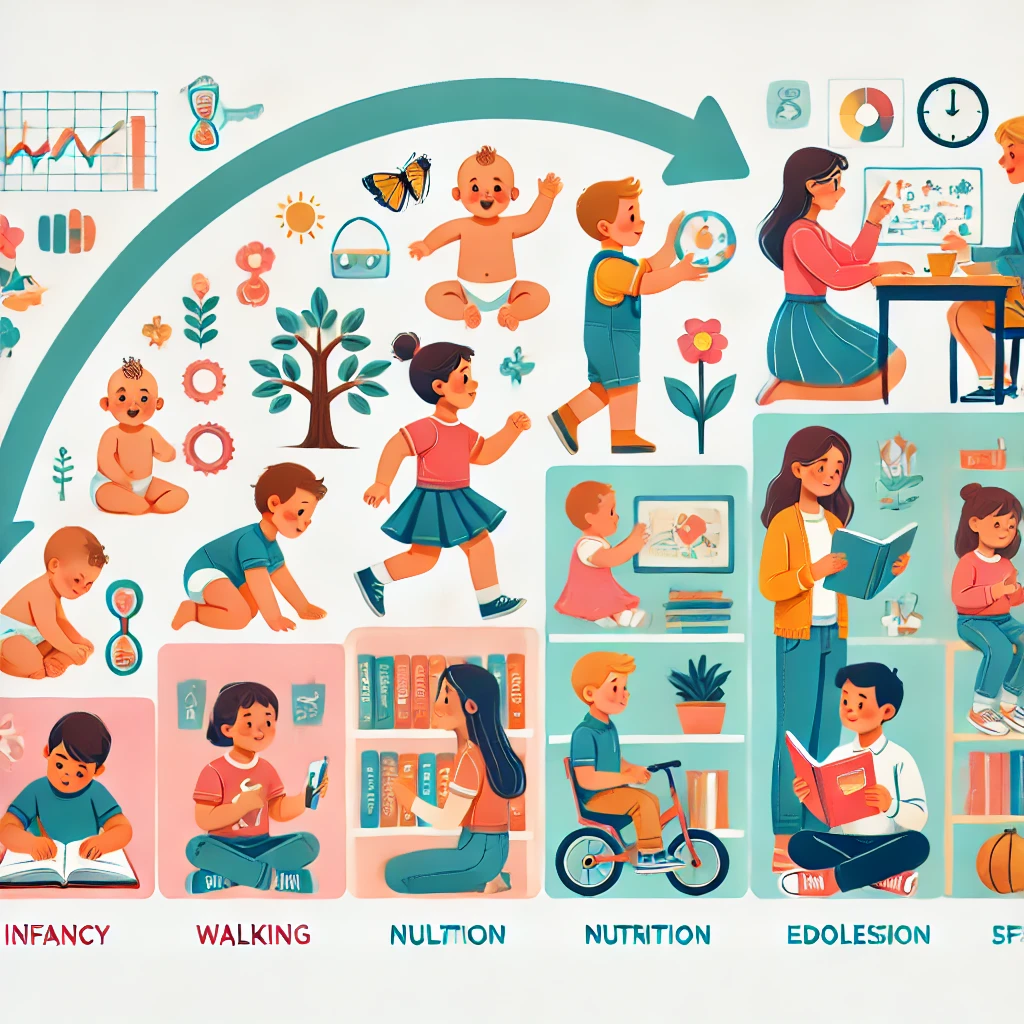Table of Contents
- Introduction
- Stages of Child Growth
- Factors Affecting Growth
- Common Concerns and Questions
- Conclusion
Article
Introduction
Child growth is a continuous process influenced by genetics, nutrition, environment, and overall health. It follows a predictable pattern, but each child develops at their own pace. Understanding these stages helps parents and caregivers ensure optimal development.

Stages of Child Growth
1. Infancy (0-1 year)
- This is the fastest period of growth in a child’s life.
- Babies typically double their birth weight by 4-6 months and triple it by their first birthday.
- Height increases by about 50% in the first year.
- Rapid brain development occurs, with sensory and motor skills improving.
- Babies learn to roll over, sit, crawl, and possibly start walking.
2. Toddlerhood (1-3 years)
- Growth slows down compared to infancy, but children continue to gain weight and height steadily.
- Muscle strength and coordination improve, allowing for walking, running, and climbing.
- Speech development begins, with toddlers starting to form sentences.
- Social and emotional growth emerges as they develop independence and begin to express emotions.
3. Preschool (3-5 years)
- Children grow at a steady pace, gaining about 2.5 inches and 4-5 pounds per year.
- Cognitive and motor skills advance, allowing for better coordination and problem-solving.
- Language skills improve significantly, with children able to speak in complete sentences.
- Social development includes learning to share, cooperate, and make friends.
4. School Age (6-12 years)
- Growth remains steady, with an average height increase of about 2 inches per year.
- Children become more physically active, developing stronger muscles and bones.
- Cognitive abilities expand, enabling better reasoning, memory, and concentration.
- Social skills improve as children engage in teamwork and peer relationships.
5. Adolescence (13-18 years)
- Puberty leads to rapid physical changes, including height and muscle growth.
- Growth spurts vary between individuals, with boys typically growing later than girls.
- Hormonal changes influence emotions, mood, and behavior.
- Development of identity, independence, and critical thinking skills occurs.
Factors Affecting Growth
1. Genetics
- Inherited traits determine a child’s height, body structure, and growth potential.
- Children with taller parents are likely to be taller, while those with shorter parents may have a similar stature.
2. Nutrition
- A balanced diet rich in proteins, vitamins, and minerals is essential for growth.
- Calcium and vitamin D support bone health, while iron and zinc contribute to overall development.
- Malnutrition can lead to stunted growth and developmental delays.
3. Physical Activity
- Regular exercise helps in muscle development, bone strength, and overall fitness.
- Activities like running, jumping, and sports enhance motor skills and coordination.
- A sedentary lifestyle may contribute to obesity and health issues.
4. Sleep
- Growth hormone is primarily released during sleep, making adequate rest essential.
- Sleep requirements:
- Infants (0-1 year): 14-17 hours per day
- Toddlers (1-3 years): 11-14 hours per day
- Preschoolers (3-5 years): 10-13 hours per day
- School-age children (6-12 years): 9-12 hours per day
- Teenagers (13-18 years): 8-10 hours per day
5. Healthcare
- Regular medical check-ups monitor growth and detect any health concerns early.
- Vaccinations, deworming, and vitamin supplements (if needed) contribute to proper growth.
- Conditions like hormonal imbalances or chronic illnesses may require medical intervention.

Common Concerns and Questions
Q: What should I do if my child is not growing as expected?
A: If a child’s growth seems delayed, consult a pediatrician. They will assess dietary habits, physical activity levels, and check for possible medical conditions. Growth charts and tests may be used to determine if intervention is needed.
Q: Can a child grow taller after puberty?
A: Growth plates in bones close after puberty, making further height increase unlikely. However, maintaining good posture, a healthy diet, and exercise can improve overall body structure and prevent slouching.
Q: How can I ensure my child grows properly?
A: Ensure they receive proper nutrition, engage in physical activities, get enough sleep, and attend regular health check-ups. Encouraging a healthy lifestyle from an early age supports optimal growth.
Conclusion
Child growth is a complex process influenced by genetics, nutrition, physical activity, sleep, and healthcare. While growth patterns vary, providing children with a healthy environment ensures proper development. If there are concerns about a child’s growth, professional guidance from a pediatrician is recommended.

